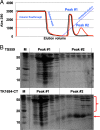Distinct Physiological Roles of the Three Ferredoxins Encoded in the Hyperthermophilic Archaeon Thermococcus kodakarensis
- PMID: 30837343
- PMCID: PMC6401487
- DOI: 10.1128/mBio.02807-18
Distinct Physiological Roles of the Three Ferredoxins Encoded in the Hyperthermophilic Archaeon Thermococcus kodakarensis
Abstract
Control of electron flux is critical in both natural and bioengineered systems to maximize energy gains. Both small molecules and proteins shuttle high-energy, low-potential electrons liberated during catabolism through diverse metabolic landscapes. Ferredoxin (Fd) proteins-an abundant class of Fe-S-containing small proteins-are essential in many species for energy conservation and ATP production strategies. It remains difficult to model electron flow through complicated metabolisms and in systems in which multiple Fd proteins are present. The overlap of activity and/or limitations of electron flux through each Fd can limit physiology and metabolic engineering strategies. Here we establish the interplay, reactivity, and physiological role(s) of the three ferredoxin proteins in the model hyperthermophile Thermococcus kodakarensis We demonstrate that the three loci encoding known Fds are subject to distinct regulatory mechanisms and that specific Fds are utilized to shuttle electrons to separate respiratory and energy production complexes during different physiological states. The results obtained argue that unique physiological roles have been established for each Fd and that continued use of T. kodakarensis and related hydrogen-evolving species as bioengineering platforms must account for the distinct Fd partnerships that limit flux to desired electron acceptors. Extrapolating our results more broadly, the retention of multiple Fd isoforms in most species argues that specialized Fd partnerships are likely to influence electron flux throughout biology.IMPORTANCE High-energy electrons liberated during catabolic processes can be exploited for energy-conserving mechanisms. Maximal energy gains demand these valuable electrons be accurately shuttled from electron donor to appropriate electron acceptor. Proteinaceous electron carriers such as ferredoxins offer opportunities to exploit specific ferredoxin partnerships to ensure that electron flux to critical physiological pathways is aligned with maximal energy gains. Most species encode many ferredoxin isoforms, but very little is known about the role of individual ferredoxins in most systems. Our results detail that ferredoxin isoforms make largely unique and distinct protein interactions in vivo and that flux through one ferredoxin often cannot be recovered by flux through a different ferredoxin isoform. The results obtained more broadly suggest that ferredoxin isoforms throughout biological life have evolved not as generic electron shuttles, but rather serve as selective couriers of valuable low-potential electrons from select electron donors to desirable electron acceptors.
Keywords: Thermococcus kodakarensis; archaea; electron flux; ferredoxin; hydrogenase; hyperthermophile.
Copyright © 2019 Burkhart et al.
Figures





References
Publication types
MeSH terms
Substances
LinkOut - more resources
Full Text Sources
Other Literature Sources
Miscellaneous
